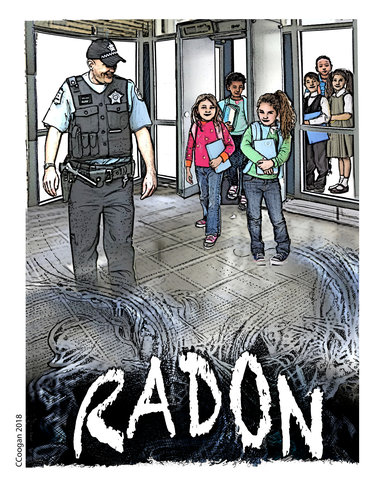Metal detectors won’t keep this killer out of our schools.
There may be a quiet killer in some of our schools. Not the kind that is stopped by bullet-proof glass, security cameras, secure entry vestibules, police officers with guns — or any of the other myriad precautions that schools are spending huge sums on.
This killer is invisible — odorless, colorless, tasteless. It occurs naturally. It’s radon gas.
Radon may be present in our schools. Or it may not. But it’s easy to find out. Simple testing — by placing canisters — will tell.
When it comes to mass shootings, schools are actually one of the safest places people gather, according to a 2015 study, “Prevalence and Offense Characteristics of Multiple Casualty Homicides: Are Schools at Higher Risk Than Other Locations?,” by researchers from the University of Virginia, Erin K. Nekvasil and Dewey G. Cornell, and from the University of Missouri, Francis L. Huang.
The researchers used the FBI’s National Incident Based Reporting System to examine 18,873 homicide incidents involving 25,180 victims who were either killed or injured from 2005 through 2010. They learned that multiple-casualty homicides were “surprisingly common events,” with about 22 percent of homicide incidents involving two or more victims. Multiple-casualty homicides were much more common in residences (47 percent) versus schools (0.8 percent).
This corresponds with what the Centers for Disease Control and Prevention stated in its National Violent Death Reporting system: Homicides at school, or traveling to and from school, make up only 1 to 2 percent of homicides of school-aged children.
The researchers concluded, “The public perception that schools are a high-risk location for homicides is inaccurate. Although concern about school shootings is understandable, the larger problem of multiple casualty shootings is more common in other locations which do not receive comparable media attention.”
We believe those final words get to the heart of the matter — media attention. There are no breaking news reports on deaths caused by radon. Our television screens and newspaper pages are not filled with compelling reports on deaths from radon, with pictures of mourning friends and relatives, with life stories of those who died.
Why? They are not mass events. Radon takes years to wreak havoc on healthy lungs. Kids that may have breathed in radon at their schools wouldn’t be diagnosed with lung cancer until years later.
There is no immediate link of cause and effect. There is no way of even knowing over the course of a lifetime where specifically the radon came from that caused the damage.
According to the federal Environmental Protection Agency, radon is the number-one cause of lung cancer among people who do not smoke, and it is the second-leading cause of lung cancer for people who do. Radon causes about 20,000 deaths annually, says the EPA. That is more deaths than caused by liver cancer, or esophageal cancer, or ovarian cancer, or brain cancer, or kidney cancer, or cervix cancer, or stomach cancer — the list goes on. Lung cancer from radon also causes more deaths each year than drunk driving, or drowning, or fires in the home.
All this despite the fact that it is easily avoidable. The EPA has recommended a guideline of 4 picoCuries per liter. Anything over that limit should be remediated. Levels lower than that “still pose a risk, and in many cases may be reduced,” according to the agency’s 2012 A Citizen’s Guide to Radon.
This is not breaking news. In 2005, thirteen years ago, the former United States Surgeon General, Richard H. Carmona, issued a health advisory warning Americans about the health risk from exposure to radon in indoor air. The Chief Physician urged Americans to test their homes to find out how much radon they might be breathing.
Four years later, the World Health Organization launched an international radon project to help countries increase awareness, collect data, and encourage action to reduce radon-related risks. “Radon poses an easily reducible health risk to populations all over the world, but has not up to now received widespread attention,” said Dr. Michael Repacholi, coordinator of WHO’s Radiation and Environmental Health Unit, at that time.
Radon, the EPA explains in its guide, comes from the natural, radioactive breakdown of uranium in soil, rock, and water, typically moving up through the ground to the air above and into buildings through cracks and holds.
Since people spend most of their time at home, they are most likely to be exposed to radon there. Children also spend a large part of their days in school. The EPA recommends testing homes and schools every two years, and remediating when the average of a first and a follow-up test is 4 picoCuries per liter or more.
New Yorkers can obtain a kit to test their homes for radon from the state’s Department of Health. It’s as simple as filling out a form and returning it with $11 per detector ordered. It takes from six to eight weeks to be processed. The department keeps a list of certified mitigation contractors, and a radon test after a mitigation system is installed is free.
A mitigation system draws radon-laden soil gas from beneath a building’s foundation and exhausts it outside of the building, far enough away from windows and other openings that it will not re-enter. Radon-reduction systems for homes nationally average $1,200 with a range from $800 to $1,500 common depending on house and market conditions.
There are currently no state or federal requirements that homes or schools be tested but we strenuously urge that the EPA guidelines be followed.
We reported a decade ago that the Guilderland schools were on the vanguard of radon testing. Testing done at the high school in 2008 found the media office, the auditorium, the east gym, a few science classrooms, the wrestling room and the coaches’ room all had readings above 4 picoCuries per liter. All of those were under 10 except the wrestling room, which was at 22.7.
Although mitigations systems were installed, recent testing — a decade after the initial tests — showed action levels in some of those same places. The auditorium had results of 12.3 in one area, and 7.7 in another. The wrestling room had a result of 9 in one area and 4.1 in another.
We urge all of our schools to put policies in place that will require testing every two years as the EPA advises. We know schools are forced to comply with many unfunded mandates. We also known that, while school leaders are well meaning and put the safety of their students as a top priority, that procedures like radon testing can fall by the wayside unless they are part of a written policy as administrators come and go and as other matters become pressing.
While mitigation systems for schools can cost tens of thousands of dollars, we believe it is money well spent. We hope as well to awaken the public to the need for radon testing and remediation in schools.
Parents have been vigilant in the wake of school shootings to demand increased security measures in their schools. But the health of their children, in the long run, is far more likely to be affected by this silent killer — radon.

